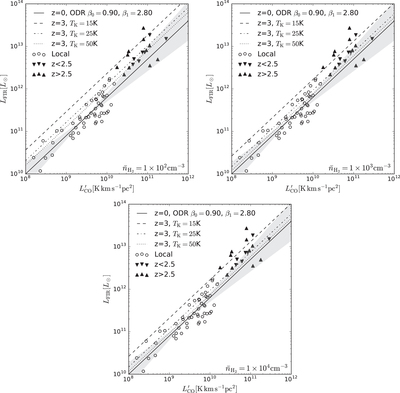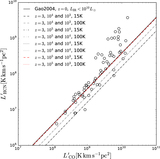Image Details

Caption: Figure 4.
Effect of the CMB on the ﹩{L}_{\mathrm{FIR}}\mbox{--}{L}_{\mathrm{CO}}^{{\prime} }﹩ relation at z = 3 for a range of kinetic temperatures with ﹩{\bar{n}}_{{{\rm{H}}}_{2}}=1\times {10}^{2}﹩ cm−2 (left), ﹩{\bar{n}}_{{{\rm{H}}}_{2}}=1\times {10}^{3}﹩ cm−3 (right), and ﹩{\bar{n}}_{{{\rm{H}}}_{2}}=1\times {10}^{4}﹩ cm−3 (bottom) calculated using RADEX. Data are recalculated from Greve et al. (2014) to use LFIR as defined in the rest of this paper over the range of 40–500 μm. We fit only the z < 1 galaxies with orthogonal distance regression (ODR), and find ﹩{\mathrm{log}}_{10}({L}_{\mathrm{FIR}})=(0.90\pm 0.06){\mathrm{log}}_{10}({L}_{\mathrm{CO}}^{{\prime} })+(2.8\pm 0.6)﹩ and is shown by the solid line. The 3σ uncertainty in the ODR fit is indicated by the gray-shaded area. The high-redshift galaxies all appear to lie consistently above the z = 0 relation, consistent with the predicted CMB effects.
Copyright and Terms & Conditions
© 2017. The American Astronomical Society. All rights reserved.









